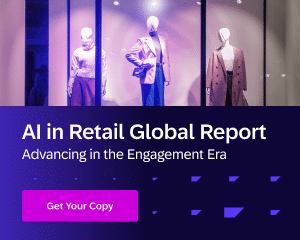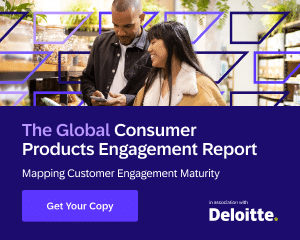Retail hasn’t simply changed, it has evolved.
Thinking of retail as strictly brick-and-mortar or strictly e-commerce seems antiquated. Now, brands know that customer engagement happens in-store and online — wherever, whenever, and however the customer chooses. It’s marketing’s responsibility to help increase growth and revenue by engaging customers and delivering true 1:1 personalized experiences across any and all channels.
In other words, it’s marketing’s job to improve the bottom-line for the business using omnichannel marketing.
Some marketers may say, “easier said than done,” and they may have a list of pain points that prevent them from rising to the challenge and driving business results. However, the most successful brand marketers would beg to differ.
In this quick guide, we’ll look at 5 common challenges that marketers face, and how some of today’s leading brand marketers have solved them.
#1. “How can I deliver the right message, at the right time, to the right customer?”
Today, sending the same one-size-fits-all message across every channel at the same time is easy. Some of the most basic tech stacks can accommodate this. But a one-to-many approach is not nearly as effective as delivering a personalized 1:1 message to a customer on the channel they prefer, and at the moment when it could make the most impact. So how do you deliver the right message, at the right time, to the right customer?
Solution: Unify all your data into a single source within your customer engagement platform.
Bringing all your data into one single source gives you a unified view of your customer. This allows you to send more selective, precise, and impactful communications to your customers.
Here’s how Sally Europe is able to deliver the right message at the right time to the right customer by having their data unified into a single source within their customer engagement platform.
“We use [Emarsys] as our enhanced SCV, and we link this with our other agencies and channels for contact. Then we go on to the channel that the customer purchases on. So whenever they purchase in-store, online, or the call center, that purchase behavior is fed into that one single source. And having all that data in the one single source, that allows us then to interrogate that data, to make decisions whether to reward or target customers through whatever channel then best resonates with that customer. And that can be store, call center, web, your web channel. That can be email, SMS, targeted social, pre-bought vouchers or even a store card. And having that breadth of channels available to us allows us to be sure that we are hitting the customer where they want to see the most relevant message.”
Simon Rowlands
Head of Customer Marketing & Comms, Sally Europe
#2. “How can I deliver meaningful, 1:1 personalization?”
True 1:1 personalization is now a customer expectation. Customers want to be understood and appreciated as individuals. The problem is, to truly understand your customer, you need a confluence of data and information. Many organizations actually have this data, but when it’s scattered and kept at arms-length from marketing, you end up with an incomplete view of your customer, and an inability to deliver the true 1:1 personalized experiences that lead to better business outcomes.
Solution: Break down channel data silos for a more complete understanding of your customer.
Breaking down silos lets you connect the dots between all the data points pertaining to your customer. A more complete understanding of your customer allows you to deliver the highly personalized 1:1 experiences the customer deserves.
Here’s how Total Tools improved their 1:1 personalization by breaking down data silos:
“One of the biggest challenges that we had in our existing environment is that our channel data was in silos, so we couldn’t deliver that coordinated communication or conversation with our customer. Now with Emarsys we’ve been able to combine all of our data. So our sales data, the big ones — offline and online — loyalty profiles, product catalogues, web interactions, email engagement data, [are] all in one central location in the CDP. So we’ve really been able to connect the dots, and also synchronize in near real time as well. And as a result of being able to stitch that data together, we’ve got a really nice unified customer view which is helping us start to enable and unleash that one-to-one personalization.”
Elisse Jones
National Loyalty Manager, Total Tools
#3. “How do I create more unique opportunities to interact with customers?”
Maybe a discount or some other offering brought the customer to your website or into your store. They might have even made a purchase. But to have an ongoing relationship with your customer, you need to uncover more opportunities for engagement, create more interactions, and deliver more meaningful experiences.
Solution: Leverage data and analytics to create more customer engagement opportunities.
If you’re only going off of a customer’s recent purchase history, you’re leaving opportunities on the table. Leveraging the data and analytics available to you will yield additional, novel ways for engaging your customer. This will allow you to develop a lasting relationship and build long-term loyalty.
Here’s how Corelle Brands leveraged data and analytics within their customer engagement platform to create lasting relationships:
“We also really leveraged analytics. Not only looking inside the Emarsys platform and using Smart Insights [to find] out what products [customers are] buying from us, [but] what is that conversation out there? … We also found out that the people who started baking, there were a lot of beginners. And so [we started] taking other things like recipes, and bringing those to the forefront, and showing how we can also help not only in just selling [customers] the product, but showing [them] how to use it, so [they] learn to love it. They’ll come back and want more because, for us, it’s really not just selling a product to the consumer, it’s connecting in that whole experience. So, we leveraged the data to be an extension of our team.”
Lindsay Ball
Sr. Digital Marketing Manager, Corelle Brands
Want to drive measurable business outcomes with omnichannel retail?
#4. “How do I continue the conversation with the customer after they leave the store?”
A customer enters your store. Rapport is established. The sales team gets to know the customer. Recommendations are offered, inventory is browsed. But after the customer leaves the store, the conversation usually ends. One of the biggest challenges for retailers with brick-and-mortar locations is: how do you continue the conversation with the customer after they’ve left the store?
Solution: Connect online and offline by identifying customers at the store level.
Find ways to identify customers in your stores: loyalty programs, receipts, email capture, scan-in with coupon/voucher barcode, QR codes, e-receipt post-purchase. Once your customers are no longer anonymous, you can continue the conversation, and they’ll continue their journey with your brand.
Here’s how Cue Clothing Co. used the customer data in their customer engagement platform to offer recommendations and continue the conversation with the customer:
“If we think about the [customer’s] online journey … if they abandon cart or even abandon the browser, we retarget them. We know what they’ve looked at, at the store level. If someone comes in, tries on five items, they’re not quite sure, not quite ready to buy, traditionally, we don’t have those mechanisms to continue the conversation. But in this instance, it’s no problem. I’ll craft this wishlist for [the customer], [they] can go away later and have a look at it online. We have the opportunity then to notify them if the inventory is low, if the [item is] back in stock, if there’s a price drop. And it’s really [about] bringing those two channels together and utilizing Emarsys recommendations off the back of that, through all the communication we send.”
Shane Lenton
CIO, Cue Clothing Co.
#5. “How can I market to customers proactively, instead of reactively?”
From a customer’s perspective, receiving marketing messages in response to their actions or purchases feels less personal and more like… well, regular ol’ marketing. But when you’re able to predict a customer’s purchasing needs, or anticipate changes in buying habits before they occur, the customer will feel like you know who they truly are on a personal level.
Solution: Use artificial intelligence to power your marketing.
Having artificial intelligence empowering all of your marketing execution will make a positive impact on your bottom line. Look for a customer engagement platform that offers AI-driven segmentation, content selection, channel execution, send-time optimization, and predictive analytics, as these AI-powered features will help you proactively market to your customers, instead of having to wait for the customer to take action.
Here’s how Bulk Powders used artificial intelligence to go from reactive to proactive marketing.
“What we’ve done with Emarsys — using their revenue MAX AI segments, which allows you to target customers based on if they’re likely to respond to email, if they’re likely to go onto the website in the next 30 days, if they’re likely to churn, or if they’re likely to actually [buy] in the next stage anyway — we were able to split out [our] replenishment program, so customers who were unlikely to buy without something extra, we were able to give them an extra voucher, which worked amazingly well. And for customers who weren’t likely to engage with our emails, we were able to put SMS in that program, or a CRM ad through Facebook. So it really took our replenishment program to the next level [and] made it much more sophisticated … We’ve been running that now for about three months and seeing an absolute, phenomenal uplift. More than I expected to see.”
Amy Smith
Head of Customer Marketing, Bulk Powders
Final Thoughts
Omnichannel marketing certainly has its challenges. However, when it’s done correctly, not only are the business rewards significant, but your customers will be more satisfied.
If your marketing team is feeling the pain getting certain key aspects of omnichannel marketing right, you’re not alone. The good news is, there are other brands who have overcome those challenges to deliver phenomenal results for their business. Ultimately, many of the common omnichannel marketing pain points can be soothed and cured with the right omnichannel customer engagement platform.
How does the only omnichannel customer engagement platform built to accelerate business outcomes help YOU solve YOUR OMNICHANNEL MARKETING CHALLENGES?
Handpicked Related Content:












